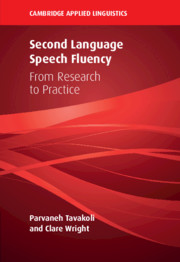Book contents
- Second Language Speech Fluency
- The Cambridge Applied Linguistics Series
- Second Language Speech Fluency
- Copyright page
- Dedication
- Contents
- Figures
- Tables
- 1 Introduction
- 2 Fluency from a Psycholinguistic Perspective
- 3 Measuring Fluency
- 4 Fluency in Second Language Task-Based Research
- 5 Fluency in Second Language Pedagogy
- 6 Fluency in Second Language Testing
- 7 Fluency in Different Contexts
- 8 Conclusion
- Appendix: Fluency Descriptors across Time
- References
- Author Index
- Subject Index
3 - Measuring Fluency
Published online by Cambridge University Press: 15 December 2020
- Second Language Speech Fluency
- The Cambridge Applied Linguistics Series
- Second Language Speech Fluency
- Copyright page
- Dedication
- Contents
- Figures
- Tables
- 1 Introduction
- 2 Fluency from a Psycholinguistic Perspective
- 3 Measuring Fluency
- 4 Fluency in Second Language Task-Based Research
- 5 Fluency in Second Language Pedagogy
- 6 Fluency in Second Language Testing
- 7 Fluency in Different Contexts
- 8 Conclusion
- Appendix: Fluency Descriptors across Time
- References
- Author Index
- Subject Index
Summary
This chapter provides a synthesis of the complex range of current practices in measuring fluency, from temporal features of speech such as speech rate and frequency of pauses, to prosodic features of speech such as intonation and stress patterns, and sociolinguistic features of turn taking and degree of dominance in a conversation, and highlights the complexities involved in measuring L2 fluency. After providing a historical perspective to the measurement of fluency, we will present a summary of the most frequently used fluency features in SLA studies, and conclude by offering a list of measures that have been suggested as more reliable representatives of utterance fluency.
Keywords
- Type
- Chapter
- Information
- Second Language Speech FluencyFrom Research to Practice, pp. 43 - 63Publisher: Cambridge University PressPrint publication year: 2020
- 1
- Cited by

